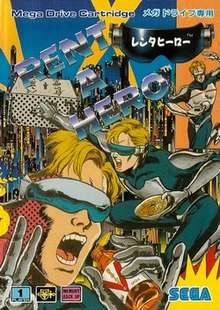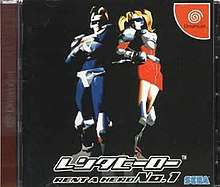Rent a Hero
Rent A Hero is an action role-playing video game series released by Sega for the Mega Drive console in 1991 with a large emphasis on humor. The game features the same graphic engine previously used in the development of Sword of Vermilion. However, Rent A Hero has an unusual innovation for the genre. Instead of using standard turn-based battles, fights are in a similar format to 2D fighting games.
| Rent-A-Hero | |
|---|---|
 | |
| Developer(s) | Sega AM2 |
| Publisher(s) | Sega |
| Producer(s) | Yu Suzuki |
| Designer(s) | Kei Dekochan Zaki Papa Kate |
| Programmer(s) | Kei |
| Writer(s) | Yukinobu Arikawa |
| Composer(s) | Hiroshi Kawaguchi |
| Platform(s) | Mega Drive |
| Release |
|
| Genre(s) | Action role-playing |
| Mode(s) | Single-player |
Plot
Taro Yamada, or "Rent A Hero" (レンタヒーロー, Renta Hīrō) lives in the town of Corja in Japan with his mother, eccentric father and younger sister Alyssa; the family moved there after his father changed jobs. He received his Combat Armor by accident during their house-warming party, when he ordered pizza from 'Sensational Cafeteria' or SECA and instead received the suit. After realizing the suit gave him incredible strength and that he is required to pay for the armor, Taro decides to become a hero for hire, performing various heroic tasks and odd-jobs for the townspeople of Corja.
Release
Rent A Hero was released for the Mega Drive on September 20, 1991, in Japan by Sega.[1][2] It was later released on the Wii's Virtual Console download service on April 17, 2007.[2]
Remake
Rent-A-Hero No. 1
| Rent-A-Hero No. 1 | |
|---|---|
 | |
| Developer(s) | Sega |
| Publisher(s) | Dreamcast Xbox |
| Composer(s) | Hiroshi Kawaguchi |
| Platform(s) | Dreamcast, Xbox |
| Release | Dreamcast
|
| Genre(s) | Action role-playing |
| Mode(s) | Single-player |
Rent A Hero No. 1, a remake of the original Mega Drive game, was released for the Dreamcast in 2000. It features similar events to Rent A Hero, this time adding Rent A Hiroko, a female counterpart of Taro. The fighting engine used for the game is the same used for Sega's Spikeout games and allows the player to receive hints via in-game email.
The game was enhanced and given online capabilities by Coolnet Entertainment for the Xbox in 2003, and also translated into English for a North American release in what would have been the first Rent A Hero overseas release. However, the English version of the game was never released due to distribution problems, and the Xbox version remained only in Japan as had previously happened with the original Dreamcast version.
In 2008, the unreleased English-translated version of the game got leaked and appeared on torrent sites in an apparently complete state, with only minor text errors present. This version was very close to completion and was reviewed by GamePro and Electronics Gaming Monthly in February 2003.
Other media
Taro is available in Fighters Megamix as an unlockable character. He is one of few characters to use projectile attacks, and one of the strongest fighters. However, he has an additional handicap: above his life bar are battery symbols, that deplete the longer a fight lasts, if they deplete fully, Taro's armor will disappear. In this state, he will not be able to perform a number of moves, including all projectile moves, and he will also take more damage.
Reception
| Reception | ||||||||||
|---|---|---|---|---|---|---|---|---|---|---|
| ||||||||||
On release, Famitsu magazine scored the Dreamcast version of the game a 30 out of 40.[3] IGN called it "a bordering-on-cheesy, yet outstanding action-RPG". They praised the 3D combat system, comparing it to SpikeOut and Shenmue, as well as "the meticulous attention to detail" in "around five large neighborhoods, each with plenty of houses, universities, and restaurants" as well as a video arcade with minigames. They also praised the animation and "brilliantly rendered graphics", concluding that "the gameplay is tightly focused, it looks great, and definitely has a soul".[5]
GameSpot called it a "wacky" game that is "definitely unique and uniquely Sega". They praised the battle system, comparing it to Virtua Fighter and Dynamite Deka, as well as the "admirable" camera work, "rock-steady 60fps" and "fluid" character animation. They criticized the character models for not looking "as nice as" Soul Calibur or Shenmue, but praised the environments for having "a texture quality that rivals" Sonic Adventure, indoor and outdoor designs that "are nothing short of breathtaking" and "a large number of suburban homes" where "each house is unique". They concluded that it is "a humorous, irreverent joy to experience" and a "surprisingly excellent game."[4]
Film adaptation
In July 12, 2016, Steve Pink will direct and co-write with Jeff Morris a film version of Rent-A-Hero.[6]
See also
References
- [セガハード大百科] メガドライブ対応ソフトウェア(セガ発売) (in Japanese). Sega. Archived from the original on November 24, 2012. Retrieved December 18, 2015.
- レンタヒーロー まとめ [メガドライブ]. Famitsu. Kadokawa Corporation. Archived from the original on March 19, 2016. Retrieved August 29, 2016.
- ドリームキャスト – レンタヒーロー No.1. Weekly Famitsu. No.915 Pt.2. Pg.51. 30 June 2006.
- http://www.gamespot.com/reviews/rent-a-hero-no-1-import-review/1900-2587281/
- http://ign.com/articles/2000/06/01/rent-a-hero-no-1-import
- Evry, Max (July 12, 2016). "Steve Pink to Direct Sega's Rent a Hero Movie". Coming Soon.
